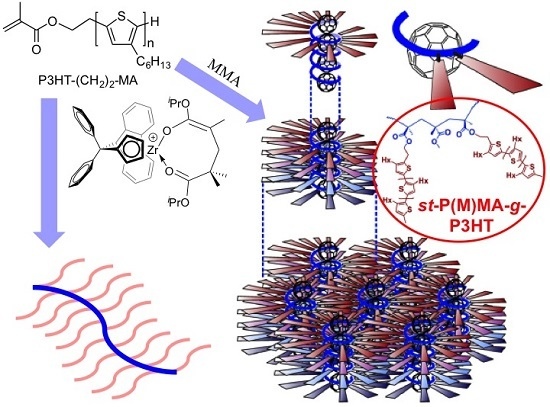Stereoregular Brush Polymers and Graft Copolymers by Chiral Zirconocene-Mediated Coordination Polymerization of P3HT Macromers
Abstract
:1. Introduction
2. Materials and Methods
2.1. General Information
2.2. Synthesis of P3HT with H/Br Chain-Ends, H-P3HT-Br
2.3. Synthesis of Macromer P3HT-(CH2)2-MA
2.4. Synthesis of P3HT-CH2-MA
2.5. General Polymerization Procedures
2.6. Encapsulation of Acceptor C60 by st-P(M)MA-g-P3HT
3. Results and Discussion
3.1. Synthesis of Macromers P3HT-(CH2)2-MA and P3HT-CH2-MA
3.2. Homopolymerization of P3HT-MA Macromers and Theirs Copolymerization with MMA
3.3. Thermal Behavior of Brush Polymers and Graft Copolymers and Inclusion Complex Formation between C60 and st-P(M)MA-g-P3HT
4. Conclusions
Acknowledgments
Author Contributions
Conflicts of Interest
References
- Sirringhaus, H.; Tessler, N.; Friend, R.H. Integrated optoelectronic devices based on conjugated polymers. Science 1998, 280, 1741–1744. [Google Scholar] [CrossRef] [PubMed]
- Roncali, J. Conjugated poly(thiophenes): Synthesis, functionalization, and applications. Chem. Rev. 1992, 92, 711–738. [Google Scholar] [CrossRef]
- Sirringhaus, H.; Brown, P.J.; Friend, R.H.; Nielsen, M.M.; Bechgaard, K.; Langeveld-Voss, B.M.W.; Spiering, A.J.H.; Janssen, R.A.J.; Meijer, E.W.; Herwig, P.; et al. Two-dimensional charge transport in self-organized, high-mobility conjugated polymers. Nature 1999, 401, 685–688. [Google Scholar] [CrossRef]
- Zaumseil, J.; Sirringhaus, H. Electron and ambipolar transport in organic field-effect transistors. Chem. Rev. 2007, 107, 1296–1323. [Google Scholar] [CrossRef] [PubMed]
- Mas-Torrent, M.; Rovira, C. Role of molecular order and solid-state structure in organic field-effect transistors. Chem. Rev. 2011, 111, 4833–4856. [Google Scholar] [CrossRef] [PubMed]
- Wang, C.; Dong, H.; Hu, W.; Liu, Y.; Zhu, D. Semiconducting π-conjugated systems in field-effect transistors: A material odyssey of organic electronics. Chem. Rev. 2012, 112, 2208–2267. [Google Scholar] [CrossRef] [PubMed]
- Ma, W.; Yang, C.Y.; Gong, X.; Lee, K.; Heeger, A. Thermally stable, efficient polymer solar cells with nanoscale control of the interpenetrating network morphology. J. Adv. Funct. Mater. 2005, 15, 1617–1622. [Google Scholar] [CrossRef]
- Dou, L.; You, J.; Hong, Z.; Xu, Z.; Li, G.; Street, R.A.; Yang, Y. 25th anniversary article: A decade of organic/polymeric photovoltaic research. Adv. Mater. 2013, 25, 6642–6671. [Google Scholar] [CrossRef] [PubMed]
- Liu, F.; Gu, Y.; Shen, X.; Ferdous, S.; Wang, H.; Russell, T.P. Characterization of the morphology of solution-processed bulk heterojunction organic photovoltaics. Prog. Polym. Sci. 2013, 38, 1990–2052. [Google Scholar] [CrossRef]
- Li, G.; Shrotriya, V.; Huang, J.; Yao, Y.; Moriarty, T.; Emery, K.; Yang, Y. High-efficiency solution processable polymer photovoltaic cells by self-organization of polymer blends. Nat. Mater. 2005, 4, 864–868. [Google Scholar] [CrossRef]
- Kim, K.; Liu, J.; Namboothiry, M.A.G.; Carroll, D.L. Thermal diffusion processes in bulk heterojunction formation for poly-3-hexylthiophene/C-60 single heterojunction photovoltaics. Appl. Phys. Lett. 2006, 88, 181911-1–181911-3. [Google Scholar] [CrossRef]
- Woo, C.H.; Thompson, B.C.; Kim, B.J.; Toney, M.F.; Fréchet, J.M.J. The influence of poly(3-hexylthiophene) regioregularity on fullerene-composite solar cell performance. J. Am. Chem. Soc. 2008, 130, 16324–16329. [Google Scholar] [CrossRef] [PubMed]
- Dang, M.T.; Hirsch, L.; Wantz, G. P3HT: PCBM, best seller in polymer photovoltaic research. Adv. Mater. 2011, 23, 3597–3602. [Google Scholar] [CrossRef] [PubMed]
- Hains, A.W.; Liang, Z.; Woodhouse, M.A.; Gregg, B.A. Molecular semiconductors in organic photovoltaic cells. Chem. Rev. 2010, 110, 6689–6735. [Google Scholar] [CrossRef] [PubMed]
- Peet, J.; Heeger, A.J.; Bazan, G.C. “Plastic” solar cells: Self-assembly of bulk heterojunction nanomaterials by spontaneous phase separation. Acc. Chem. Res. 2009, 42, 1700–1708. [Google Scholar] [CrossRef] [PubMed]
- Thompson, B.C.; Fréchet, J.M.J. Polymer–fullerene composite solar cells. Angew. Chem. Int. Ed. 2008, 47, 58–77. [Google Scholar] [CrossRef] [PubMed]
- Yang, X.; Loos, J. Toward high-performance polymer solar cells: The importance of morphology control. Macromolecules 2007, 40, 1353–1362. [Google Scholar] [CrossRef]
- Yu, G.; Hummelen, J.C.; Wudl, F.; Heeger, A.J. Polymer photovoltaic cells: Enhanced efficiencies via a network of internal donor-acceptor heterojunctions. Science 1995, 270, 1789–1791. [Google Scholar] [CrossRef]
- Higashihara, T.; Sugiyama, K.; Yoo, H.S.; Hayashi, M.; Hirao, A. Combining living anionic polymerization with branching reactions in an iterative fashion to design branched polymers. Macromol. Rapid Commun. 2010, 31, 1031–1059. [Google Scholar] [CrossRef] [PubMed]
- Higashihara, T.; Hayashi, M.; Hirao, A. Synthesis of well-defined star-branched polymers by stepwise iterative methodology using living anionic polymerization. Prog. Polym. Sci. 2011, 36, 323–375. [Google Scholar] [CrossRef]
- Higashihara, T.; Segawa, Y.; Sinananwanich, W.; Ueda, M. Synthesis of hyperbranched polymers with controlled degree of branching. Polym. J. 2012, 44, 14–29. [Google Scholar] [CrossRef]
- Higashihara, T.; Ito, S.; Fukuta, S.; Miyane, S.; Ochiai, Y.; Ishizone, T.; Ueda, M.; Hirao, M. Synthesis and characterization of multicomponent ABC- and ABCD-type miktoarm star-branched polymers containing a poly(3-hexylthiophene) segment. Macro Lett. 2016, 5, 631–635. [Google Scholar] [CrossRef]
- Hu, M.; Xia, Y.; McKenna, G.B.; Kornfield, J.A.; Grubbs, R.H. Linear rheological response of a series of densely branched brush polymers. Macromolecules 2011, 44, 6935–6943. [Google Scholar] [CrossRef]
- Heinrich, C.D.; Thelakkat, M. Poly-(3-hexylthiophene) bottlebrush copolymers with tailored side-chain lengths and high charge carrier mobilities. J. Mater. Chem. C 2016, 4, 5370–5378. [Google Scholar] [CrossRef]
- Khanduyeva, N.; Senkovskyy, V.; Beryozkina, T.; Bocharova, V.; Simon, F.; Nitschke, M.; Stamm, M.; Grötzschel, R.; Kiriy, A. Grafting of poly(3-hexylthiophene) from poly(4-bromostyrene) films by Kumada catalyst-transfer polycondensation: Revealing of the composite films structure. Macromolecules 2008, 41, 7383–7389. [Google Scholar] [CrossRef]
- Khanduyeva, N.; Senkovskyy, V.; Beryozkina, T.; Horecha, M.; Stamm, M.; Uhrich, C.; Riede, M.; Leo, K.; Kiriy, A. Surface engineering using Kumada catalyst-transfer polycondensation (KCTP): Preparation and structuring of poly(3-hexylthiophene)-based graft copolymer brushes. J. Am. Chem. Soc. 2009, 131, 153–161. [Google Scholar] [CrossRef] [PubMed]
- Paoprasert, P.; Spalenka, J.W.; Peterson, D.L.; Ruther, R.E.; Hamers, R.J.; Evansa, P.G.; Gopalan, P. Grafting of poly(3-hexylthiophene) brushes on oxides using click chemistry. J. Mater. Chem. 2010, 20, 2651–2658. [Google Scholar] [CrossRef]
- Meng, D.; Sun, J.; Jiang, S.; Zeng, Y.; Li, Y.; Yan, S.; Geng, J.; Huang, Y. Grafting P3HT brushes on GO sheets: Distinctive properties of the GO/P3HT composites due to different grafting approaches. J. Mater. Chem. 2012, 22, 21583–21591. [Google Scholar] [CrossRef]
- Chen, E.Y.-X. Coordination polymerization of polar vinyl monomers by single-site metal catalysts. Chem. Rev. 2009, 109, 5157–5214. [Google Scholar] [CrossRef] [PubMed]
- Sato, M.; Kato, T.; Ohishi, T.; Ishige, R.; Ohta, N.; White, K.L.; Hirai, T.; Takahara, A. Precise synthesis of poly(methyl methacrylate) brush with well-controlled stereoregularity using a surface-initiated living anionic polymerization method. Macromolecules 2016, 49, 2071–2076. [Google Scholar] [CrossRef]
- Bolig, A.D.; Chen, E.Y.-X. ansa-Zirconocene ester enolates: Synthesis, structure, reaction with organo-lewis acids, and application to polymerization of methacrylates. J. Am. Chem. Soc. 2004, 126, 4897–4906. [Google Scholar] [CrossRef] [PubMed]
- Zhang, Y.; Ning, Y.; Caporaso, L.; Cavallo, L.; Chen, E.Y.-X. Catalyst-site-controlled coordination polymerization of polar vinyl monomers to highly syndiotactic polymers. J. Am. Chem. Soc. 2010, 132, 2695–2709. [Google Scholar] [CrossRef] [PubMed]
- Ning, Y.; Chen, E.Y.-X. Metallocene-catalyzed polymerization of methacrylates to highly syndiotactic polymers at high temperatures. J. Am. Chem. Soc. 2008, 130, 2463–2465. [Google Scholar] [CrossRef] [PubMed]
- Kawauchi, T.; Kumaki, J.; Kitaura, A.; Okoshi, K.; Kusanagi, H.; Kobayashi, K.; Sugai, T.; Shinohara, T.; Yashima, E. Encapsulation of fullerenes in a helical pmma cavity leading to a robust processable complex with a macromolecular helicity memory. Angew. Chem. Int. Ed. 2008, 47, 515–519. [Google Scholar] [CrossRef] [PubMed]
- Vidal, F.; Falivene, L.; Caporaso, L.; Cavallo, L.; Chen, E.Y.-X. Robust crosslinked stereocomplexes and c60 inclusion complexes of vinyl-functionalized stereoregular polymers derived from chemo/stereoselective coordination polymerization. J. Am. Chem. Soc. 2016, 138, 9533–9547. [Google Scholar] [CrossRef] [PubMed]
- Iovu, M.C.; Sheina, E.E.; McCullough, R.D. Experimental evidence for the quasi-“living” nature of the grignard metathesis method for the synthesis of regioregular poly(3-alkylthiophenes). Macromolecules 2005, 38, 8649–8656. [Google Scholar] [CrossRef]
- Surin, M.; Coulembier, O.; Tran, K.; Winter, J.D.; Leclѐre, P.; Gerbaux, P.; Lazzaroni, R.; Dubois, P. Regioregular poly(3-hexylthiophene)-poly(ε-caprolactone) block copolymers: Controlled synthesis, microscopic morphology, and charge transport properties. Org. Electron 2010, 11, 767–774. [Google Scholar] [CrossRef]

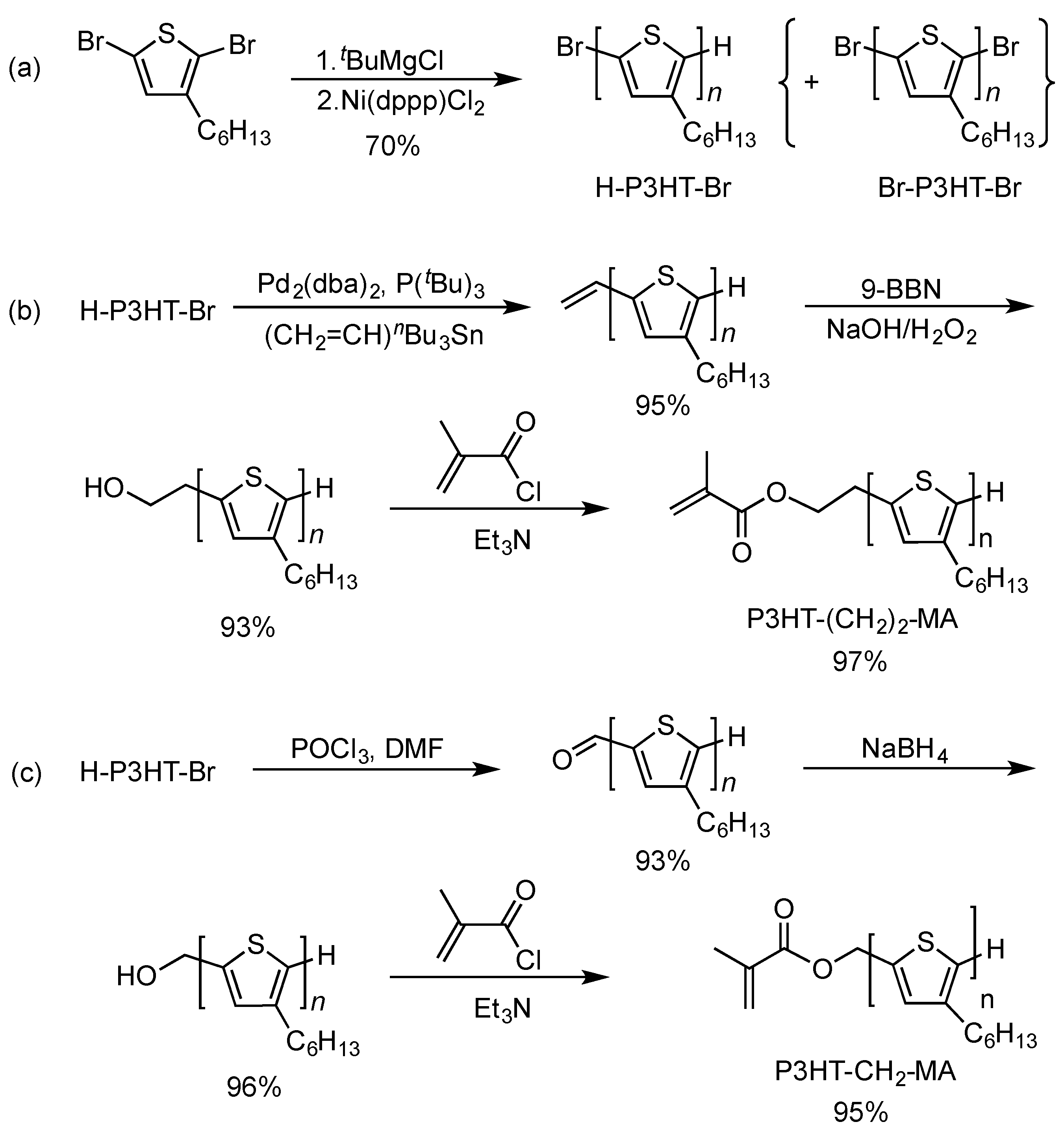
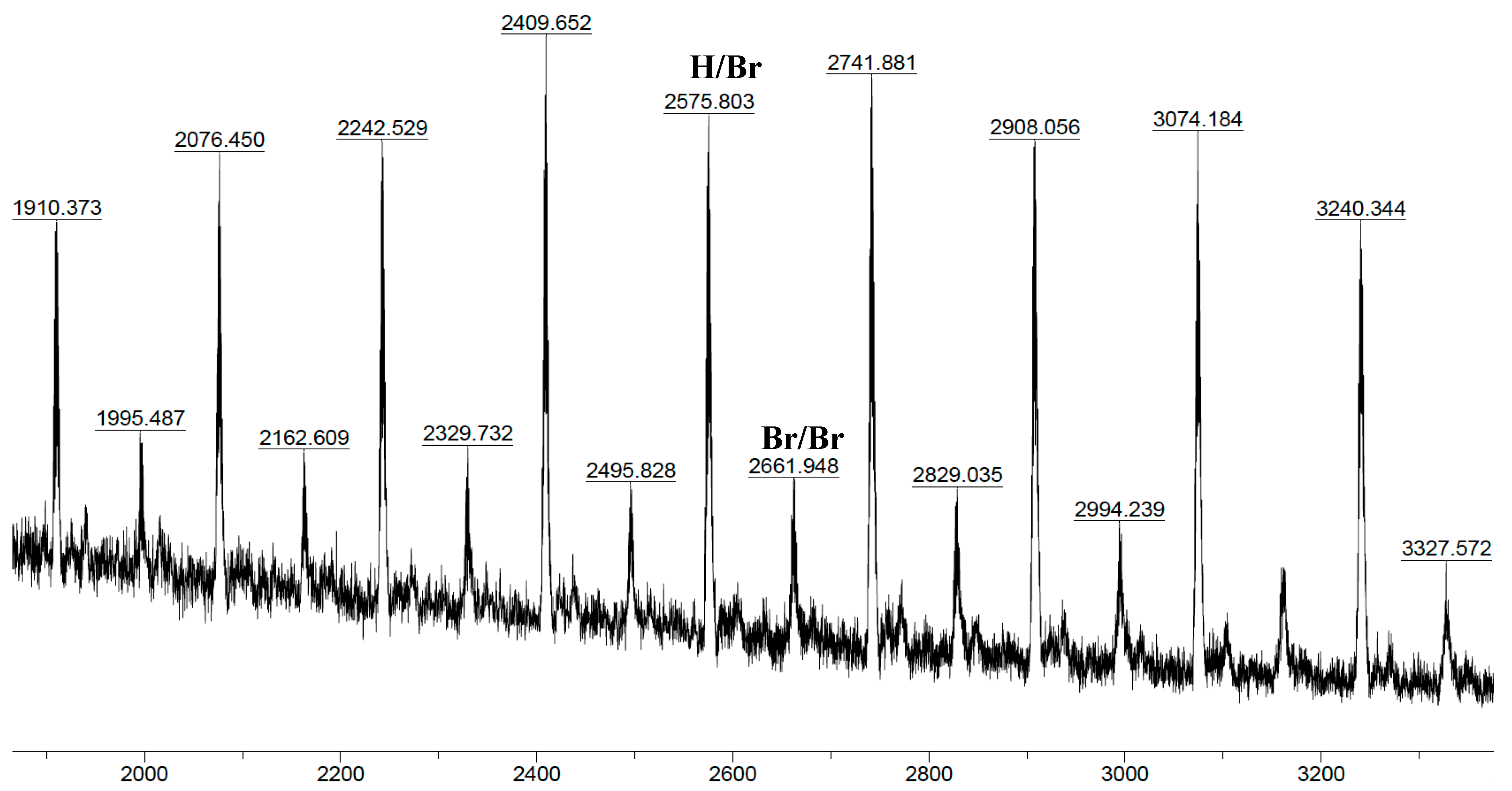


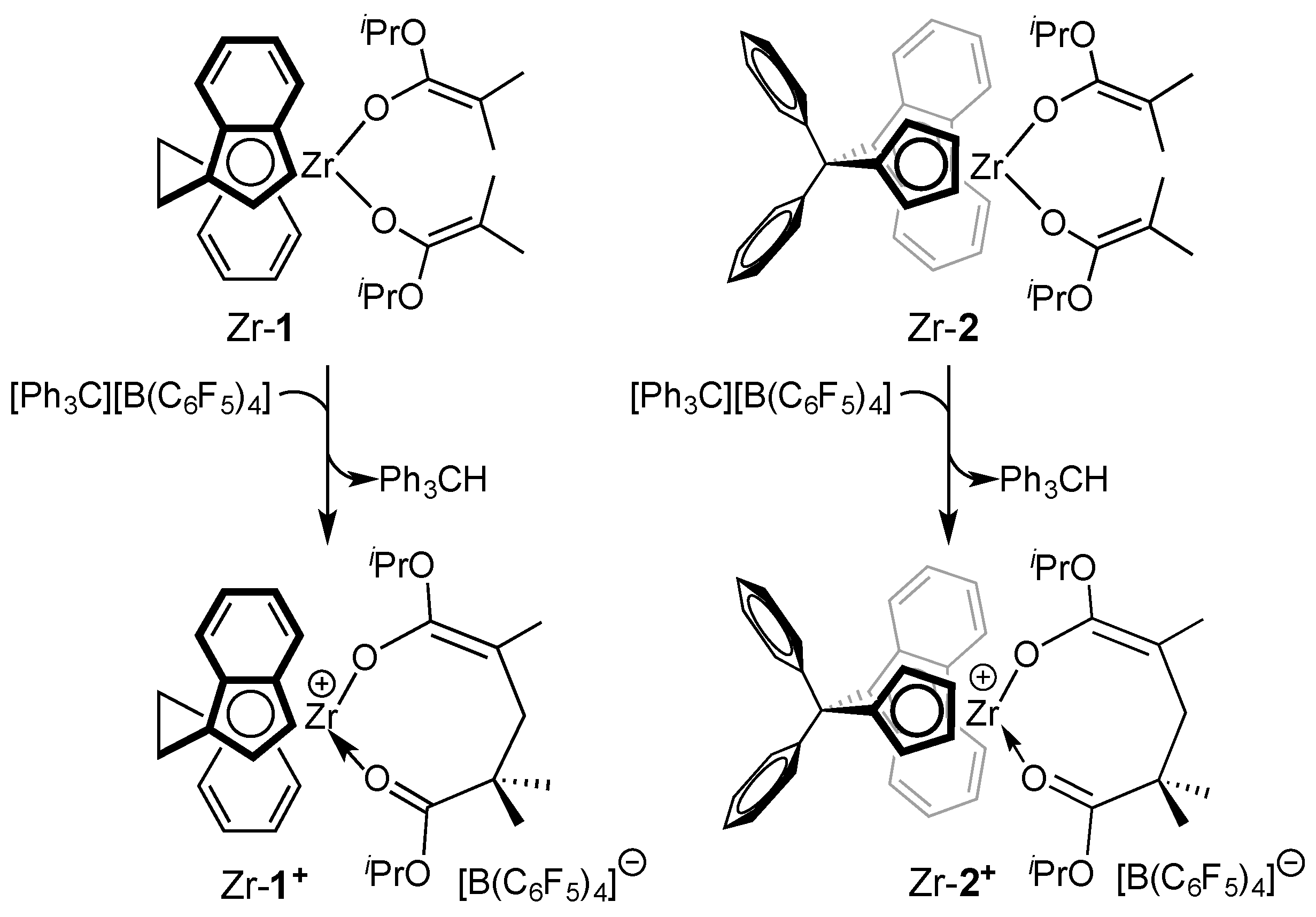

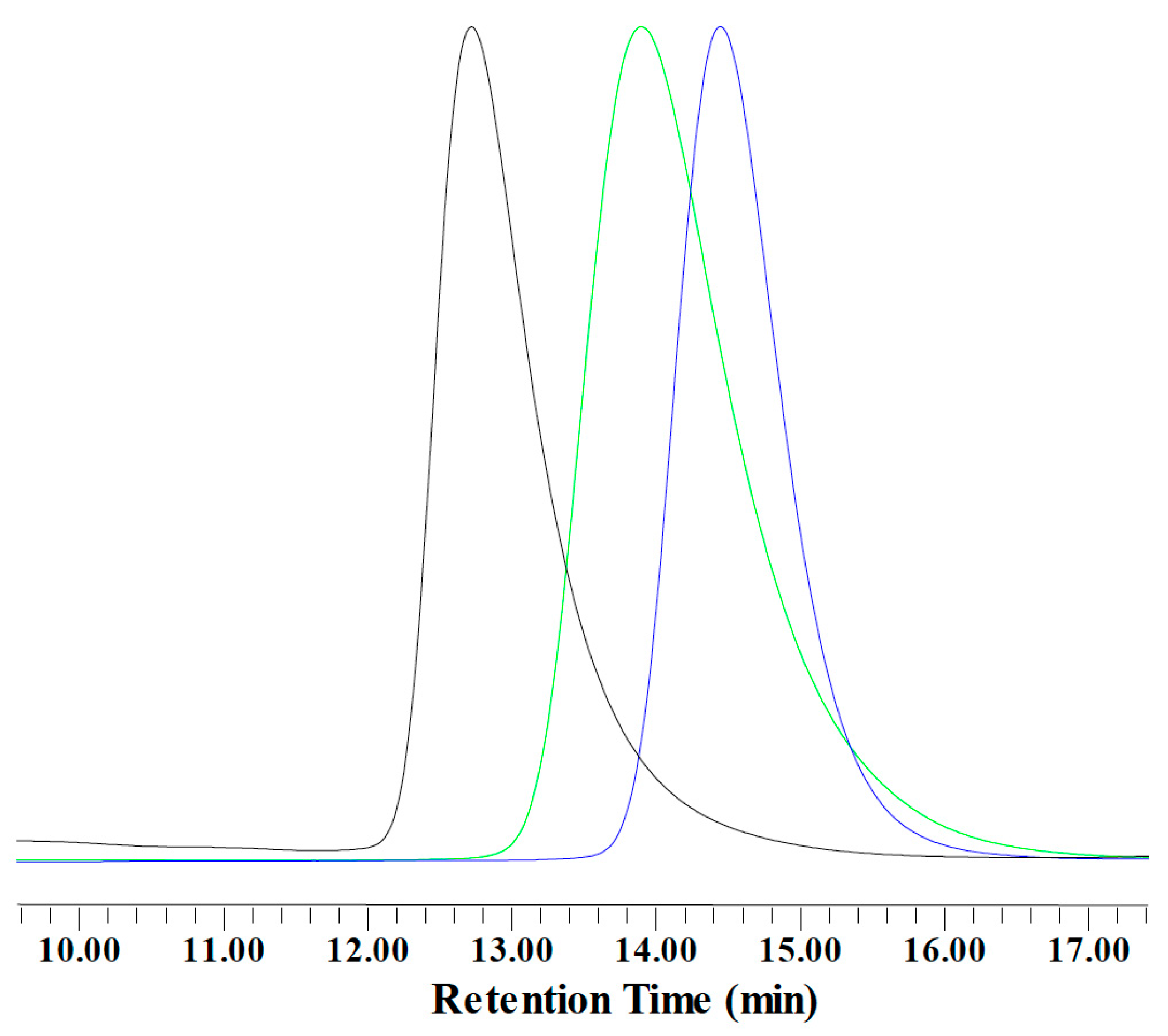


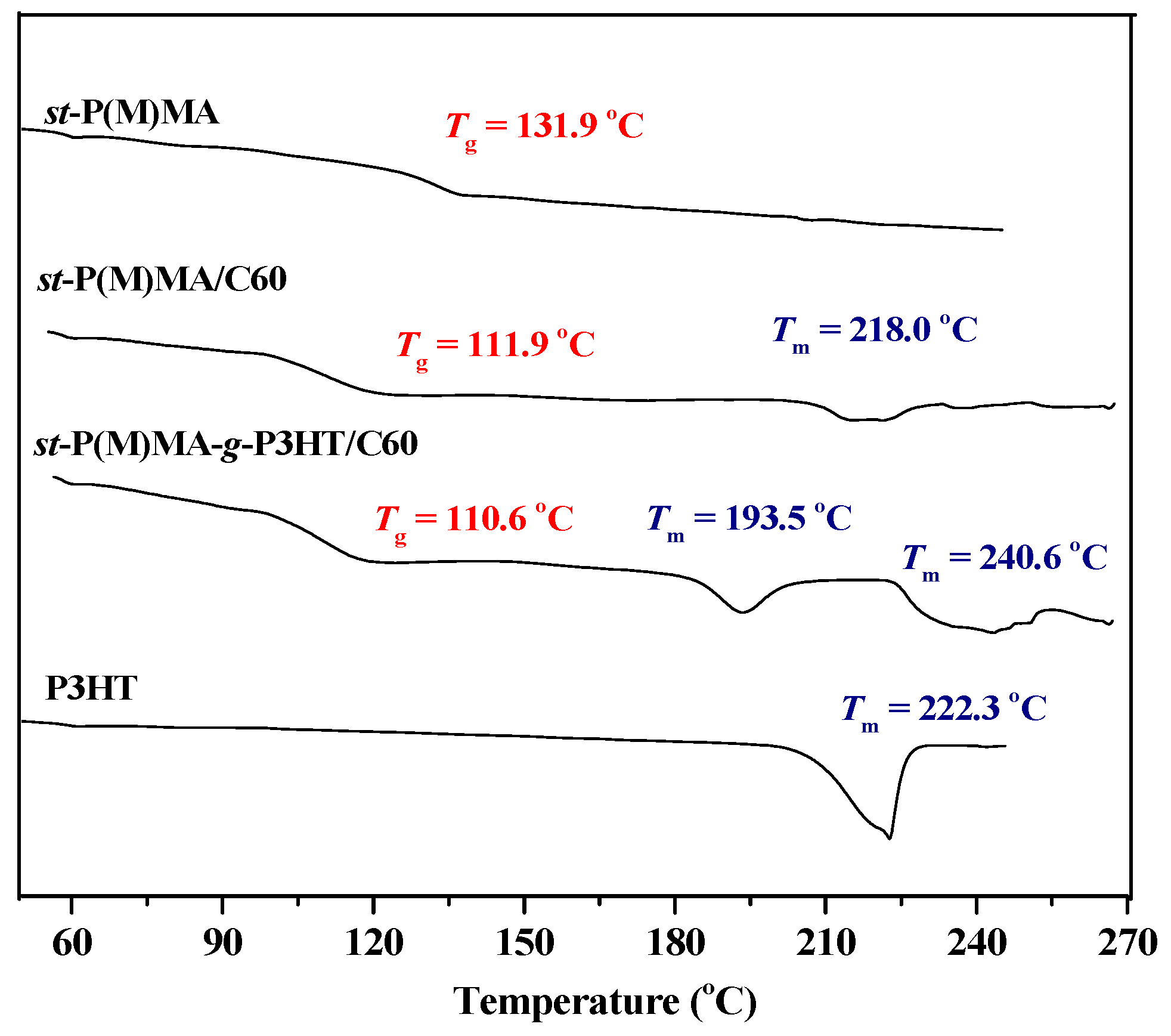
| Run | Cat. | P3HT-MA Wt, Mn b | MMA (mg) | MMA/MA-end c | Yield (mg) | P3HT d (mol %) | mm e (rr) | Tg f (°C) | Tm f (°C) | Mw g (kg/mol) | Ð g (Mw/Mn) |
|---|---|---|---|---|---|---|---|---|---|---|---|
| 1 | Zr-1+ | 50, 5000 | 0 | n/a | 46 | n/a | n/d | 53.2 | 224 | n/d | n/d |
| 2 | Zr-1+ | 30, 5000 | 230 | 383/1 | 210 | 4.3 | 92% | 51.9 | 217 | 132 | 1.25 |
| 3 | Zr-1+ | 30, 5000 | 23 | 38/1 | 45 | 13.2 | 94% | 52.3 | 216 | 27.4 | 1.14 |
| 4 | Zr-2+ | 50, 5000 | 0 | n/a | 48 | n/a | n/d | 132.8 | 219 | n/d | n/d |
| 5 | Zr-2+ | 30, 5000 | 230 | 383/1 | 200 | 3.9 | (95%) | 111.9 | 218 | 43.2 | 1.32 |
| 6 | Zr-2+ | 30, 3500 | 93 | 108/1 | 110 | 8.0 | (94%) | n/d | n/d | 33.1 | 1.15 |
| 7 | Zr-2+ | 30, 3500 | 23 | 27/1 | 43 | 14.5 | (93%) | n/d | n/d | 19.5 | 1.16 |
© 2017 by the authors. Licensee MDPI, Basel, Switzerland. This article is an open access article distributed under the terms and conditions of the Creative Commons Attribution (CC BY) license (http://creativecommons.org/licenses/by/4.0/).
Share and Cite
Wang, Y.; Bailey, T.S.; Hong, M.; Chen, E.Y.-X. Stereoregular Brush Polymers and Graft Copolymers by Chiral Zirconocene-Mediated Coordination Polymerization of P3HT Macromers. Polymers 2017, 9, 139. https://doi.org/10.3390/polym9040139
Wang Y, Bailey TS, Hong M, Chen EY-X. Stereoregular Brush Polymers and Graft Copolymers by Chiral Zirconocene-Mediated Coordination Polymerization of P3HT Macromers. Polymers. 2017; 9(4):139. https://doi.org/10.3390/polym9040139
Chicago/Turabian StyleWang, Yang, Travis S. Bailey, Miao Hong, and Eugene Y.-X. Chen. 2017. "Stereoregular Brush Polymers and Graft Copolymers by Chiral Zirconocene-Mediated Coordination Polymerization of P3HT Macromers" Polymers 9, no. 4: 139. https://doi.org/10.3390/polym9040139
APA StyleWang, Y., Bailey, T. S., Hong, M., & Chen, E. Y.-X. (2017). Stereoregular Brush Polymers and Graft Copolymers by Chiral Zirconocene-Mediated Coordination Polymerization of P3HT Macromers. Polymers, 9(4), 139. https://doi.org/10.3390/polym9040139




